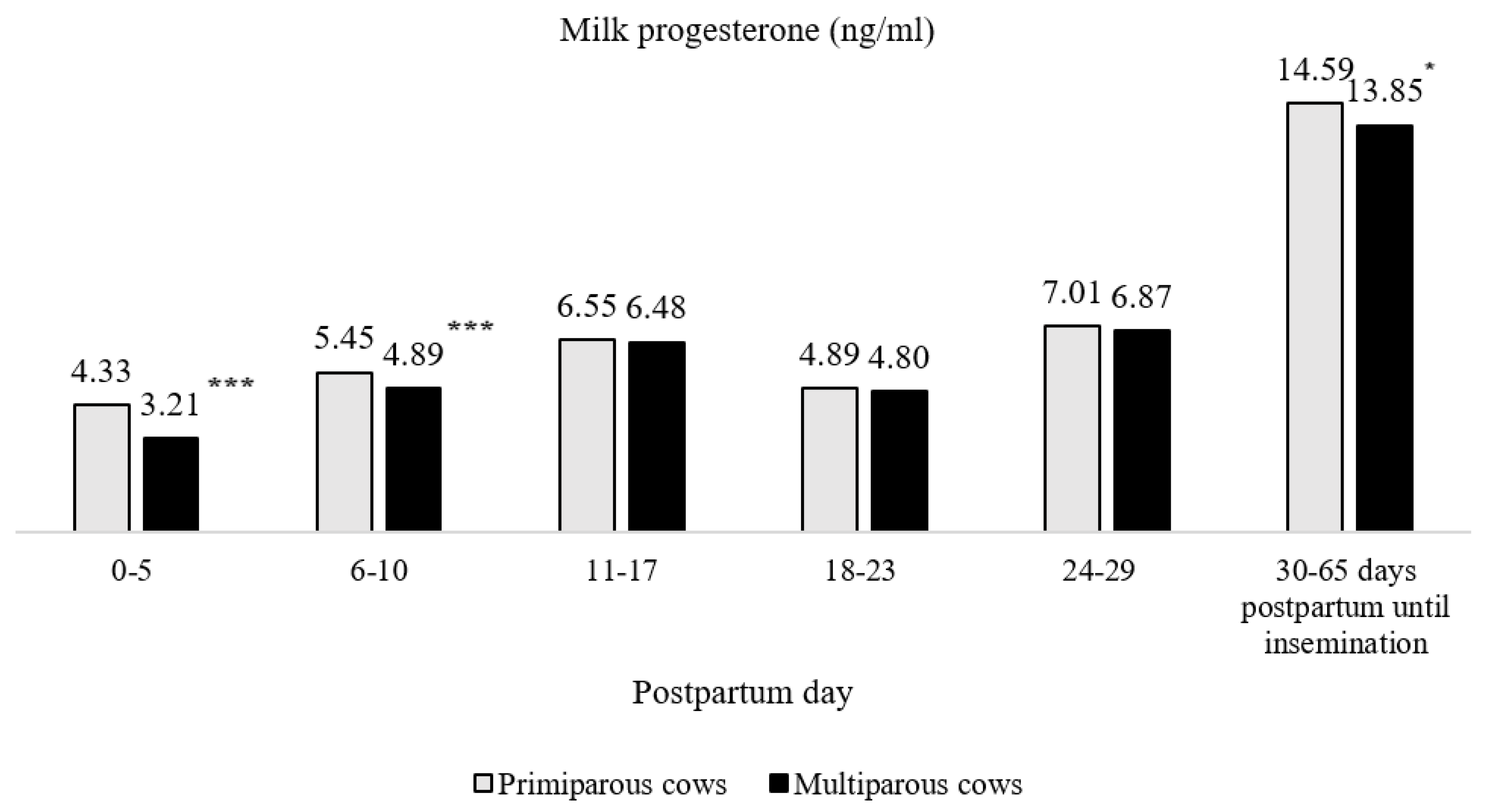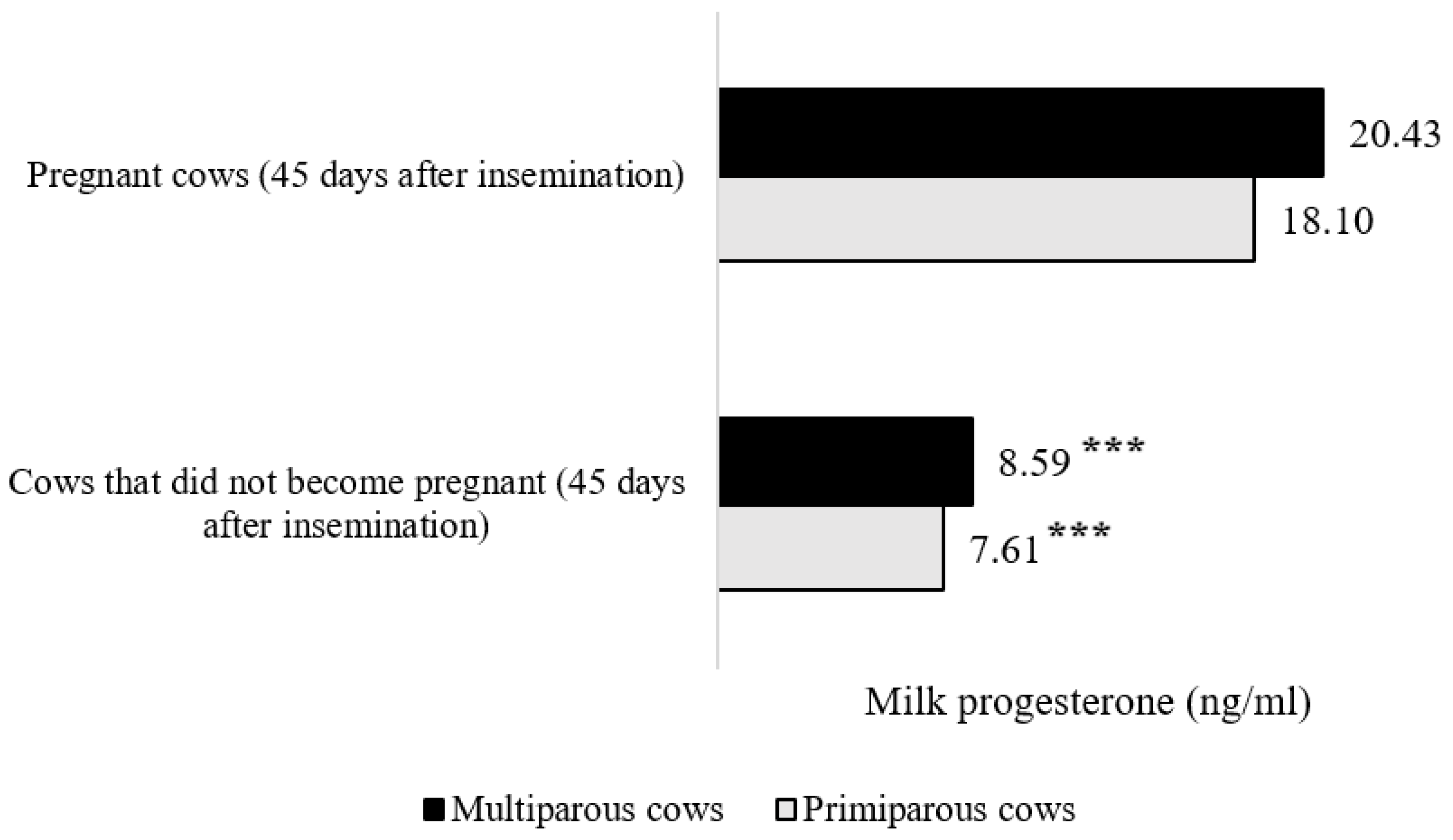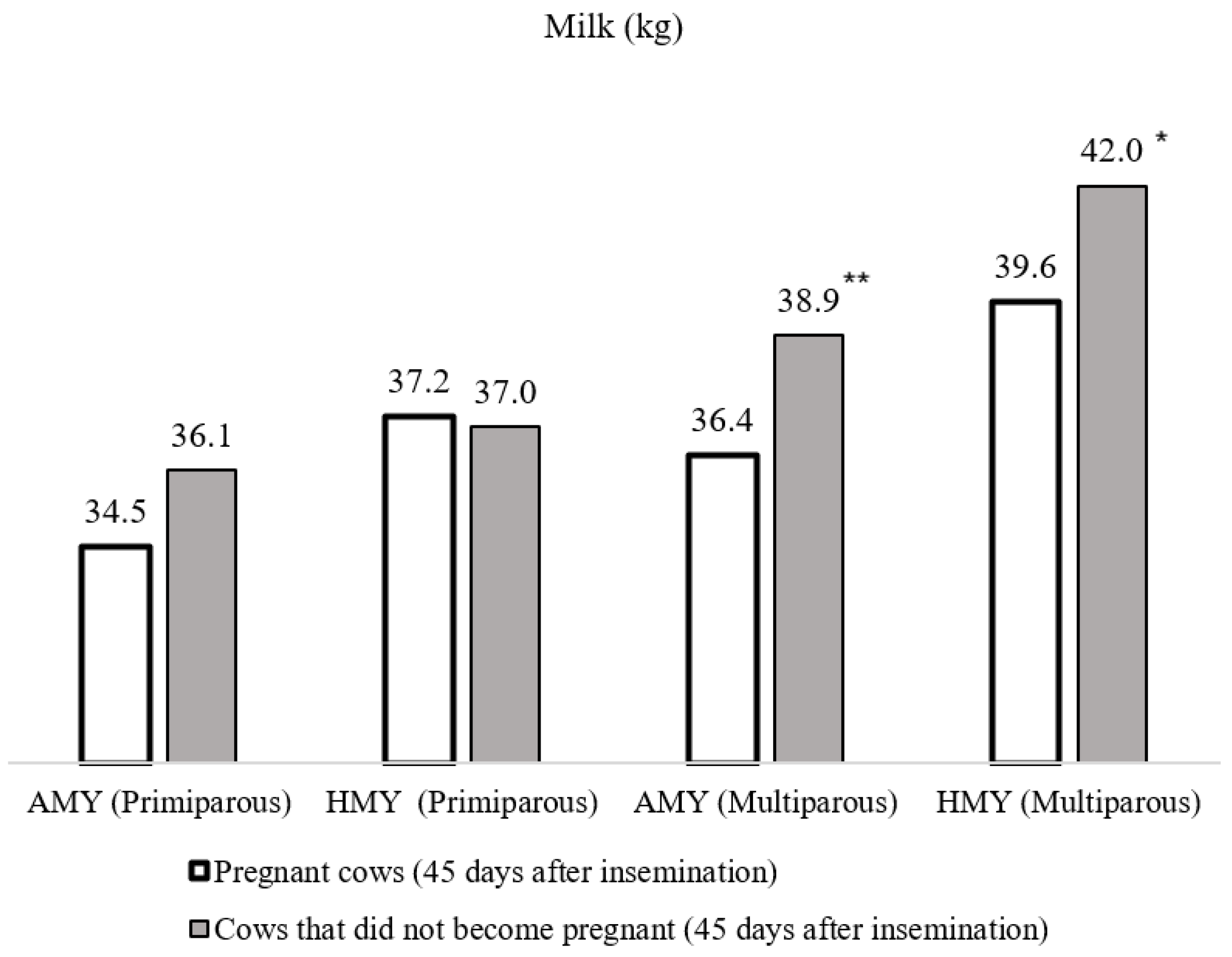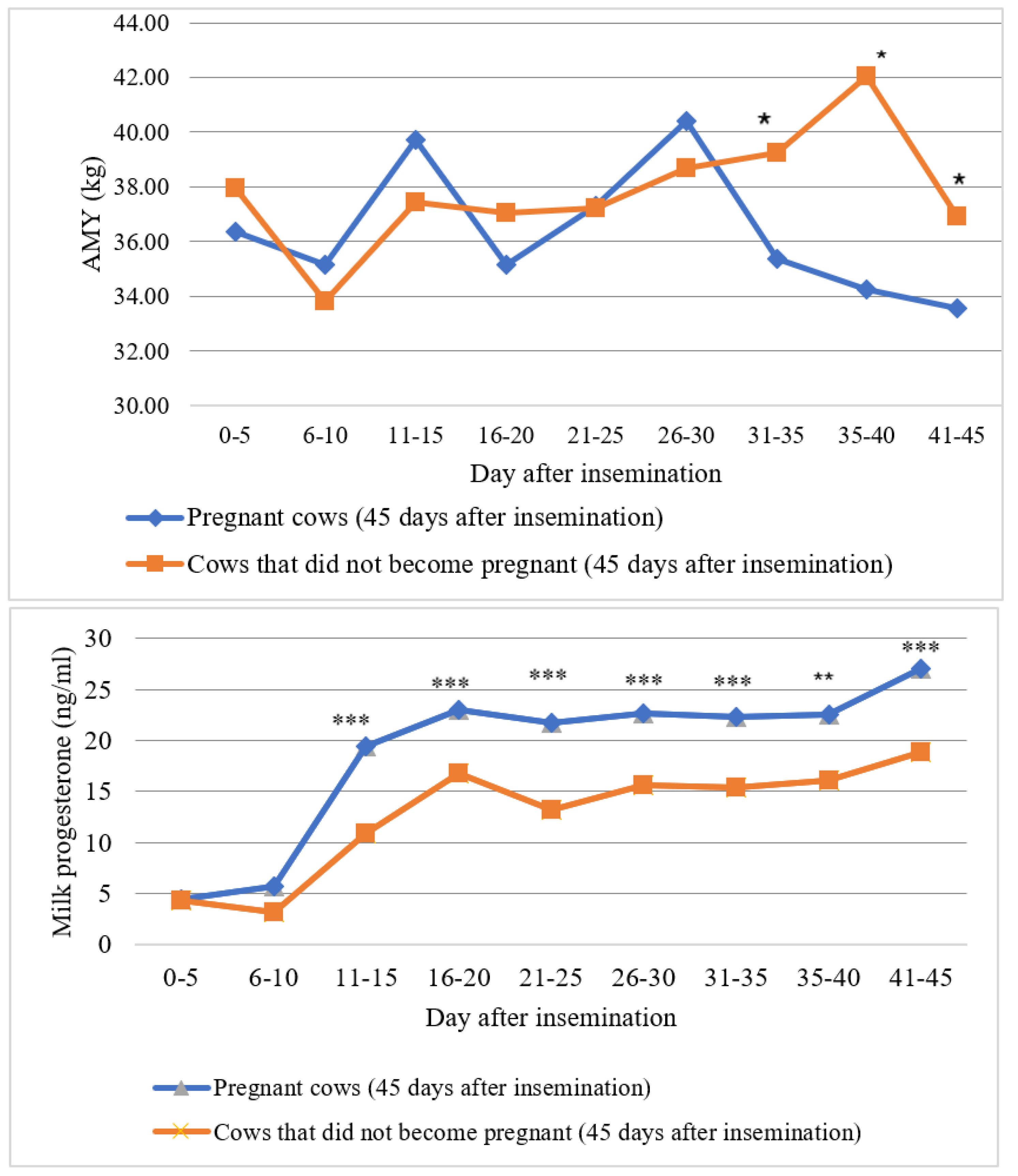Dynamic Changes in Progesterone Concentration in Cows’ Milk Determined by the At-Line Milk Analysis System Herd NavigatorTM
Simple Summary
Abstract
1. Introduction
2. Materials and Methods
2.1. Location and Experimental Design
2.2. Measurements
2.3. Animals and Experimental Conditions
2.4. Data Analysis and Statistics
3. Results
3.1. Changes in the Concentration of Milk Progesterone According to Status of Reproduction in Dairy Cows
3.2. Changes in Milk Productivity of Cows According to Status of Reproduction
3.3. Relationship of Progesterone in Milk with Productivity of Cows According to Status of Reproduction
4. Discussion
5. Conclusions
Author Contributions
Funding
Conflicts of Interest
References
- Bazer, F.W. Pregnancy recognition signaling mechanisms in ruminants and pigs. J. Anim. Sci. Biotechnol. 2013, 4, 23. [Google Scholar] [CrossRef] [PubMed]
- Adriaens, I.; Huybrechts, T.; Geerinckx, K.; Daems, D.; Lammertyn, J.; De Ketelaere, B.; Aernouts, B. Mathematical characterization of the milk progesterone profile as a leg up to individualized monitoring of reproduction status in dairy cows. Theriogenology 2017, 103, 44–51. [Google Scholar] [CrossRef] [PubMed]
- Bruinjé, T.C.; Gobikrushanth, M.; Colazo, M.G.; Ambrose, D.J. Dynamics of pre-and post-insemination progesterone profiles and insemination outcomes determined by an in-line milk analysis system in primiparous and multiparous Canadian Holstein cows. Theriogenology 2017, 102, 147–153. [Google Scholar] [CrossRef] [PubMed]
- Yu, G.M.; Maeda, T. Inline progesterone monitoring in the dairy industry. Trends Biotechnol. 2017, 35, 579–582. [Google Scholar] [CrossRef] [PubMed]
- McNeill, R.E.; Diskin, M.G.; Sreenan, J.M.; Morris, D.G. Associations between milk progesterone concentration on different days and with embryo survival during the early luteal phase in dairy cows. Theriogenology 2006, 65, 1435–1441. [Google Scholar] [CrossRef]
- Samsonova, J.V.; Safronova, V.A.; Osipov, A.P. Pretreatment-free lateral flow enzyme immunoassay for progesterone detection in whole cows’ milk. Talanta 2015, 132, 685–689. [Google Scholar] [CrossRef]
- Hommeida, A.; Nakao, T.; Kubota, H. Luteal function and conception in lactating cows and some factors influencing luteal function after first insemination. Theriogenology 2004, 62, 217–225. [Google Scholar] [CrossRef]
- Larson, S.F.; Butler, W.R.; Currie, W.B. Reduced fertility associated with low progesterone postbreeding and increased milk urea nitrogen in lactating cows. J. Dairy Sci. 1997, 80, 1288–1295. [Google Scholar] [CrossRef]
- Beam, S.W.; Butler, W.R. Effects of energy balance on follicular development and first ovulation in postpartum dairy cows. J. Reprod. Fertil. Suppl. 1999, 54, 411–424. [Google Scholar] [CrossRef]
- Berger, H.; Lietzau, M.; Tichy, A.; Herzog, K. Pregnancy outcome is influenced by luteal area during diestrus before successful insemination but not by milk production level. Theriogenology 2017, 104, 115–119. [Google Scholar] [CrossRef]
- Niswender, G.D.; Juenge, J.L.; Silva, P.J.; Rollyson, M.K.; McIntush, E.W. Mechanisms controlling the function and life span of the corpus luteum. Physiol. Rev. 2000, 80, 1–29. [Google Scholar] [CrossRef] [PubMed]
- Humblot, P. Use of pregnancy specific proteins and progesterone assays to monitor pregnancy and determine the timing, frequencies and sources of embryonic mortality in ruminants. Theriogenology 2001, 56, 1417–1433. [Google Scholar] [CrossRef]
- Herzog, K.; Voss, C.; Kastelic, J.P.; Beindorff, N.; Paul, V.; Niemann, H.; Bollwein, H. Luteal blood flow increases during the first three weeks of pregnancy in lactating dairy cows. Theriogenology 2011, 75, 549–554. [Google Scholar] [CrossRef]
- Gomez-Seco, C.; Alegr, B.; Martinez-Pastor, F.; Prieto, J.G.; Gonzalez-Montana, J.R.; Alonso, M.E.; Dominguez, J.C. Evolution of the corpus luteum volume determined ultrasonographically and its relation to the plasma progesterone concentration after artificial insemination in pregnant and non-pregnant dairy cows. Vet. Res. Commun. 2017, 41, 183–188. [Google Scholar] [CrossRef]
- Sangsritavong, S.; Combs, D.K.; Sartori, R.; Armentano, L.E.; Wiltbank, M.C. High feed intake increases liver blood flow and metabolism of progesterone and estradiol-17β in dairy cattle. J. Dairy Sci. 2002, 85, 2831–2842. [Google Scholar] [CrossRef]
- Cerri, R.L.A.; Chebel, R.C.; Rivera, F.; Narciso, C.D.; Oliveira, R.A.; Amstalden, M.; Santos, J.E.P. Concentration of progesterone during the development of the ovulatory follicle: II. Ovarian and uterine responses. J. Dairy Sci. 2011, 94, 3352–3365. [Google Scholar] [CrossRef] [PubMed]
- Pineyrua, J.T.M.; Farina, S.R.; Mendoza, A. Effects of parity on productive, reproductive, metabolic and hormonal responses of Holstein cows. Anim. Reprod. Sci. 2018, 191, 9–21. [Google Scholar] [CrossRef] [PubMed]
- Caixeta, L.S.; Ospina, P.A.; Capel, M.B.; Nydam, D.V. Association between subclinical hypocalcemia in the first 3 days of lactation and reproductive performance of dairy cows. Theriogenology 2017, 94, 1–7. [Google Scholar] [CrossRef]
- Penasa, M.; De Marchi, M.; Cassandro, M. Effects of pregnancy on milk yield, composition traits, and coagulation properties of Holstein cows. J. Dairy Sci. 2016, 99, 4864–4869. [Google Scholar] [CrossRef]
- Butler, W.R. Energy balance relationships with follicular development, ovulation and fertility in postpartum dairy cows. Livest. Prod. Sci. 2003, 83, 211–218. [Google Scholar] [CrossRef]
- Lucy, M.C. Reproductive loss in high-producing dairy cattle: Where will it end? J. Dairy Sci. 2001, 84, 1277–1293. [Google Scholar] [CrossRef]
- Piccardi, M.; Funes, A.C.; Balzarini, M.; Bó, G.A. Some factors affecting the number of days open in Argentinean dairy herds. Theriogenology 2013, 79, 760–765. [Google Scholar] [CrossRef] [PubMed]
- Cook, J.G.; Green, M.J. Use of early lactation milk recording data to predict the calving to conception interval in dairy herds. J. Dairy Sci. 2016, 99, 4699–4706. [Google Scholar] [CrossRef] [PubMed]




| Group Number/Days Postpartum | Number of Cows | |
|---|---|---|
| Multiparous | Primiparous | |
| (1) 0–5 | 20 | 18 |
| (2) 6–10 | 17 | 19 |
| (3) 11–17 | 19 | 22 |
| (4) 18–23 | 18 | 21 |
| (5) 24–29 | 20 | 23 |
| (6) 30–65 days postpartum until insemination | 47 | 53 |
| (7) 0–45 days after insemination | 30 | 37 |
| (8) Cows that did not become pregnant (45 days after insemination) | 44 | 52 |
| (9) Pregnant cows (45 days after insemination) | 78 | 86 |
| Postpartum Day | AMY | HMY | ||
|---|---|---|---|---|
| Primiparous Cows | Multiparous Cows | Primiparous Cows | Multiparous Cows | |
| 0–5 | 14.6 ± 0.91 | 15.0 ± 0.87 | 17.9 ± 0.99 | 18.4 ± 1.03 |
| 6–10 | 15.4 ± 0.62 | 16.9 ± 0.68 * | 19.8 ± 0.98 | 19.9 ± 1.09 |
| 11–17 | 22.4 ± 1.28 | 22.8 ± 1.11 | 28.5 ± 1.38 | 32.1 ± 1.62 * |
| 18–23 | 23.5 ± 1.19 | 25.1 ± 1.14 * | 27.8 ± 0.93 | 33.0 ± 1.45 * |
| 24–29 | 31.6 ± 1.92 | 31.8 ± 1.90 | 34.2 ± 2.00 | 37.3 ± 1.92 * |
| 30–65 days postpartum until insemination | 35.1 ± 1.84 | 34.5 ± 1.98 | 37.2 ± 1.86 | 38.1 ± 1.94 |
| Period/Status of Reproduction | Coefficients of Correlation | |||
|---|---|---|---|---|
| AMY | HMY | |||
| Postpartum Period | 0–30 days postpartum | 0–5 days | 0.142 | 0.072 |
| 6–10 days | 0.162 | 0.130 | ||
| 11–17 days | 0.261 | 0.207 | ||
| 18–23 days | 0.346 * | 0.324 * | ||
| 24–29 days | 0.212 | 0.275 | ||
| 30–65 days postpartum until insemination | 0.092 | 0.048 | ||
| Period after Insemination | 0–45 days after insemination | Became pregnant | 0.251 * | 0.104 |
| Did not become pregnant | 0.082 | 0.066 | ||
© 2020 by the authors. Licensee MDPI, Basel, Switzerland. This article is an open access article distributed under the terms and conditions of the Creative Commons Attribution (CC BY) license (http://creativecommons.org/licenses/by/4.0/).
Share and Cite
Antanaitis, R.; Malašauskienė, D.; Televičius, M.; Juozaitienė, V.; Žilinskas, H.; Baumgartner, W. Dynamic Changes in Progesterone Concentration in Cows’ Milk Determined by the At-Line Milk Analysis System Herd NavigatorTM. Sensors 2020, 20, 5020. https://doi.org/10.3390/s20185020
Antanaitis R, Malašauskienė D, Televičius M, Juozaitienė V, Žilinskas H, Baumgartner W. Dynamic Changes in Progesterone Concentration in Cows’ Milk Determined by the At-Line Milk Analysis System Herd NavigatorTM. Sensors. 2020; 20(18):5020. https://doi.org/10.3390/s20185020
Chicago/Turabian StyleAntanaitis, Ramūnas, Dovilė Malašauskienė, Mindaugas Televičius, Vida Juozaitienė, Henrikas Žilinskas, and Walter Baumgartner. 2020. "Dynamic Changes in Progesterone Concentration in Cows’ Milk Determined by the At-Line Milk Analysis System Herd NavigatorTM" Sensors 20, no. 18: 5020. https://doi.org/10.3390/s20185020
APA StyleAntanaitis, R., Malašauskienė, D., Televičius, M., Juozaitienė, V., Žilinskas, H., & Baumgartner, W. (2020). Dynamic Changes in Progesterone Concentration in Cows’ Milk Determined by the At-Line Milk Analysis System Herd NavigatorTM. Sensors, 20(18), 5020. https://doi.org/10.3390/s20185020






